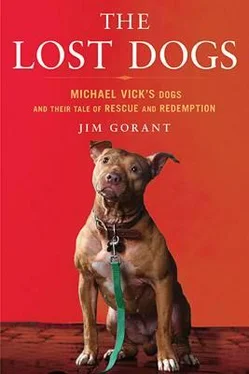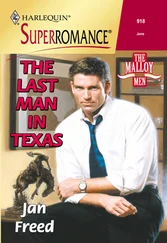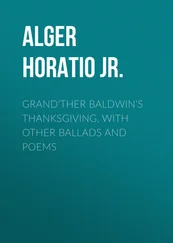On her own, Little Red kept progressing as well. After about six months, the staff had introduced a new wrinkle: cars. Instead of just walks, they began taking the dogs for rides in the afternoon. Like many of the dogs, Little Red was somewhat suspicious and uncomfortable at first. She didn’t like the sound of the engine starting and the movement. She refused to climb in and had to be placed inside.
But the car gave them greater options. They could visit other buildings and new people. And Little Red discovered the creek, a winding waterway that carved through the bottom of the canyon. The first time Carissa Hendrick took Little Red to the creek, she had the dog on a twenty-foot lead. Little Red got out of the car, saw the water, and charged across the bank and right into the drink.
It was the first time she’d been introduced to a new place and met it without fear or apprehension. Little Red loved the water, and her time at the creek helped boost her confidence even more. Her caretakers continued to take her to new places and to introduce her to new things. They knew that every time she went somewhere different or interacted with another person or animal and had a positive experience, it would help her grow. Her fear was really a fear of the unknown, and once she had the confidence that the unknown was not a bad thing, she would be able to relax and see the world for what it was.
Little Red’s worldview began to change. Instead of greeting new adventures with a sense of “Uh oh, what are we doing,” she brought more of a “Hey, what are we doing?” vibe to the day. Her world wasn’t huge, but it was getting bigger.
At the same time, negative experiences could still cause setbacks. Taking Little Red out to sit by the road and watch cars, so she could get used to the sight and sound of them, required starting out well back from the blacktop. If the cars got too close, Little Red might become unnerved and the next time she saw a car she might be even more scared than she started out.
As with many of the other dogs, taking care of Little Red became a delicate balancing act. Her handlers needed to consistently push her into new places and experiences to help her overcome her anxiety, but they also needed to manage those excursions carefully and go at a deliberate pace.

Just like that, Handsome Dan was moving on. He and Little Red had been moved to Octagon #3. They were no longer sequestered among only Vick dogs but were living happily and easily among the general population at Best Friends. Little Red was progressing well, but Handsome Dan was doing even better. In the summer of 2009, he was moved to a foster home and that December, he became one of the first Vick dogs at Best Friends to be adopted.
Little Red still had work to do. She was much more open to new situations and people but her fears prevented her from passing her Canine Good Citizen test, a must before she could move to a foster home. One part of the test required her to behave appropriately while first being approached by a stranger and then being handled by that stranger. Little Red couldn’t get through that part of the test without showing her anxiety.
Now she had lost her buddy too. Hendrick worried that Handsome Dan’s departure could cause another setback, but Little Red seemed to handle it well. She clearly missed him, but to help keep her from wondering too much about what had become of him, her handlers decided to make Little Red an “out dog.” That meant that instead of spending her time confined to her kennel and run, she would be allowed to roam around the open areas of the octagon. She had the run of the place.
This would allow her to spend her day exploring and dealing with the people in the office on a constant basis. It would also expose her to changing situations and force her to deal with all the new people that came and went. It was a chance for her to continue getting comfortable with people she didn’t know.
Those encounters could still be tough for Little Red, but her time among those she was comfortable with was a pleasure. She visited with everyone and among such friends she was playful and snuggly. She goofed around, she sat on laps, she liked nothing more than being picked up and cradled like a baby. When someone held her that way, she did everything but purr.
Before long, she could jump in and out of a car without hesitation, and she would come and go from one building to another without fear. She was no longer unsocialized; now she was simply shy. The process of drawing her out continued.
A while after Handsome Dan left she befriended another dog, a pit bull rescued from a fight ring in Missouri, and they were put together to share a kennel, playing and running during the afternoons like old buddies. The charts tracking her progress continued to trend in the right direction. Her fear, which jumped as high as an eight on a scale of one to ten at the beginning, dropped to an average of less than two. Her confidence inched above five; her happiness approached seven.
WITH HECTOR IN THE house, Cris Cohen was back to square one. He was setting up the small plastic crate beneath the window in the dining room. He was walking two dogs separately every morning. He was getting tied up in the leash and he was retracing the same old route past the little school and on to Sunset Park.
All these things reminded him of Jonny. He certainly missed the little guy, but he knew that would pass. It always did. Having Hector around helped. He demanded Cohen’s full attention. Another big, fawn-colored dog with a black snout (he could have been Leo’s twin), Hector had a series of deep brutal scars on his chest and front legs, and a few more on his snout and back legs. Unlike Jonny and many of the other remaining dogs, he’d definitely been fought. He’d also spent his time in one of the sparest shelters. And yet here he was, not perfect but in better shape than many others.
It became clear to Cohen very quickly that Hector was exceptionally smart. That meant he had great potential, but also that he would require more work. Like Jonny he could be a bit restless-remnants of the kennel stress-and downright mischievous. He stole socks from Cohen’s room, hid shoes around the house, and dragged the area rug from the bedroom down the hall to the living room.
He was also very people-focused and warm. He loved to be petted and to sit with someone. As Hector settled into the routine and began to relax, he progressed quickly. Cohen was happy to see the results, but he was struggling. He couldn’t stop thinking about Jonny.
Every time he took on a foster he gave a piece of himself away. It was impossible to do what he did without forming a close bond with the dog. The animal itself was less accepting of training if it didn’t feel a certain closeness and eagerness to please the trainer. In the past, that bond had always faded over time for Cohen. He figured the same thing would happen with Jonny, but it wasn’t. Just the opposite. He felt like he missed Jonny more and more as time went by. He had talked to Jen about his feelings a number of times, but now he became convinced he needed to do something about it.
Cris and Jen had a unique relationship. It was a partnership that extended not only to their work with dogs but their entire lives. They’d been engaged for three years and dreamed of marrying on a Spanish galleon that sailed up the coast of California. Planning it was a feat of coordination that had kept them at bay for many months, but neither of them particularly cared. They were together and staying that way, so they’d get to the wedding when they got to it.
The couple was lucky to share such a unique perspective on life and a sense that making each other happy came before all else. Cris knew how Jen would respond, and she did not disappoint. “If you feel strongly about it, you should do it,” she said. “Call up and see if you can get Jonny back.”
Читать дальше













